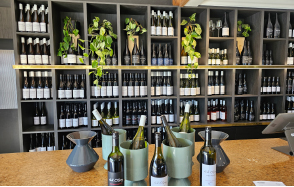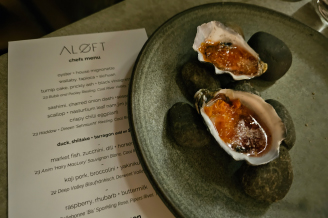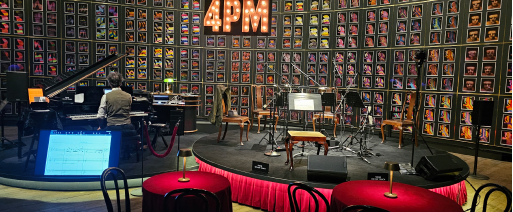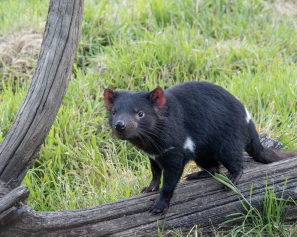AUSTRALIA’S HIDDEN GEMS
Canberra and Tasmania’s Unique Charms
Heading to the Land Down Under is always an exhilarating experience, for Australia is truly a place like no other. I’ve felt the lure many times, beginning, as most visitors do, with visits to the “Big Three” – Sydney, Melbourne and Queensland (where the Great Barrier Reef awaits).
But there’s much more to this vast island country in Oceania that’s roughly comparable in size to the United States, beginning with two hidden gems on its East Coast that merit visits all on their own.

CANBERRA, AUSTRALIA’S CAPITAL
In the late 19th century, both Sydney and Melbourne were vying to become the capital of Australia, the island that Captain Cook and the British had claimed in 1770. Beginning with turning that island home of countless Aboriginal tribes into a penal colony by 1778, by the early 1900s Australia was solidly British – and not just those of the criminal class. In 1908, everyone agreed on the future site of Canberra to be established as the capital, and it took until 1927 for the city to be built and Parliament House to open.
These days, Canberra will remind American visitors of Washington, D.C., with its wide and green Federation Mall, and the numerous museums spilling down from the massive Parliament House to the Molonglo River basin, where the Captain Cook Memorial Jet River Fountain is the iconic symbol of the city.
It’s an art-and-museum-lover’s mecca, with the National Museum of Australia, the Old Parliament House Museum of Australia, the National Gallery of Australia, the National Science Museum, the Canberra Contemporary Gallery and more all centered right in that part of the city, so if that’s your jam, plan a day (or more) to see them all. Most have free admission, too!
All cities in Australia now embrace their Aboriginal roots, with indigenous acknowledgements and an ever-growing cultural awareness. So, it isn’t surprising to visit Canberra’s beautiful National Arboretum to the west of city central, located where the Ngunnawal nation once was, and find traditional Bush Tucker and Butterfly gardens, both with ancient stories to tell. There you can wander with a fascinating Ngunnawal docent guide, who will even teach you how to throw a boomerang, along with how to use indigenous plants to heal wounds, make dinner and more.

Also nearby is Canberra’s famed Wine District, our favorite spot, where 140 wineries are creating delicious vintages of cool-climate wine varietals that delight the palate. We joined Van du Vin, Laura Jallier’s luxury wine tour (in a very nice van) to discover beautiful places like Nick O’Leary Wines’ Cellar Door, where seasonal, locally sourced dining choices paired with his 2023 Flying Fox Riesling and Seven Gates Tempranillo for a wonderful beginning.
Later that afternoon, we took in The Vintner’s Daughter’s family-run winery offerings, including a stellar 2022 Pinot Noir and a fascinating blend, their 2021 Estate Shiraz Viognier, a big red softened with the lighter white that cried out for pairing with a juicy steak. At Clonakilla Winery, their Small Batch series is exemplary, with Chardonnay and Pinot Noir reminding sippers just what a perfect cool climate can do to create wines with depth and lovely long finishes. Those thr
Happily, the burgeoning restaurant scene in Canberra focuses on regional sourcing, so there was plenty of local wine to be found in popular hotspots like Bar Rochford and Rebel, Rebel. Both those bar-restaurants have cool interior designs, ever-changing seasonal menus and top-notch food. Seek out Corella Restaurant in the hip Braddon neighborhood to be in with the in-crowd, where you’ll find a small, packed place filled with happy diners tucking into focaccia with a taste of Vegemite, seared scallops and confit duck croquettes.ee made us wish we had added time to visit many more places in this charming wine district.

Stay in Braddon at the Midnight Hotel, an easy walk to the numerous shops, bars and even micro-breweries that have made this area so popular; and even if you have to wait for a table, there’s plenty of friendly Aussies at the bar, ready and willing to chat with visitors. The hotel features the Midnight Bar, which always seems to be hoppin’, offering up creative seasonal cocktails and a lively scene; plus, there’s a seriously nice, 20-meter indoor swimming pool for when you’re ready to swim or just soak.
For a Michelin Guide-recommended spot, choose the Ovolo Nishi, where opulent modern rooms pair up with a slew of amenities, including an on-site art gallery and an art-house cinema, plus a spa and pilates studio. It’s in New Acton, another Canberra district filled with a lively scene of bars, shops and welcoming dining spots.
No matter where you lay your head, be sure to consider getting up early to experience one of the city’s famed air-balloon adventures; the city’s populace loves them so much, they hold the annual Canberra Balloon Spectacular in March, so schedule accordingly if you do, too.


TASMANIA,
THE PLACE TO BREATHE DEEPLY
The other less-visited East Coast destination is Tasmania, the island that is the southernmost state of Australia (there are six states total), and the place that is known to have the cleanest air on the planet.
So that’s the first thing to do when you arrive in Hobart, take a big deep breath! Then begin to explore this place that boasts the massive Tasmanian Wilderness, where almost a quarter of the island is protected. That’s what the UNESCO World Heritage cites as “one of the most spectacular temperate wilderness areas” in the world as well as an Aboriginal cultural landscape preserved for those people who have lived here for more than 35,000 years.
Visiting that western wilderness means you can hike the famed Overland Track, see Cradle Mountain and much more, by choosing an Aboriginal guided bushwalking tour from one to fifteen days long. If you’re not so hardy, book a small-plane flight with Par Avion and they’ll whisk you over it in one day or take you to their remote wilderness camp for a three-day adventure.

Back in Hobart, the state capital where you landed, there’s also so much to see and do that you just might want to spend a week or more here. Cool hotels abound, all very close to the city’s famous harbor, including The Tasman Hobart, which combines sleek modernity in an 1840s building with amazing water views, or the nearby Henry Jones Art Hotel, which is a transformed waterfront warehouse filled with so many artworks throughout that they even offer a tour of their collection.
Hobart is a sophisticated harbor city, bursting with fascinating history, amazing art museums, delightful restaurants and even Tasmanian Devils. Those little marsupials aren’t roaming the city streets, however, so make a plan to grab a rental car and head to Bonorong Wildlife Sanctuary to see them up close.
That’s where Greg Irons devotes his days to rescuing those little devils, as well as many other types of wildlife indigenous to Tasmania. You can actually look through one-way, soundproof glass right into where a veterinarian is assessing the latest critters to arrive at Bonorong. Irons and his team rescue countless animals every year, which is why the sanctuary is such a rewarding place to visit. Tasmanian devils (who are actually adorable little creatures) run to say hello to Irons, as do the kangaroos, wombats, ringtail possums, echidnas, emus, kookaburras and other rescued indigenous animals.
Getting out into nature is easy with Hobart as home base, so plan to spend a day on Bruny Island, south of the city. Drive down on your own, or take a guided tour with Pennicott Wilderness Journeys, to discover everything from the gorgeous Tasman Sea Lookout at The Neck, where spotting little penguins is a delight, to slurping down local oysters at Get Shucked and tasting locally made chocolate at Bruny Island Chocolate Company.
Perhaps the biggest delight on scenic Bruny Island is spotting the white wallabies, albino mutations of the normally brown Bennett’s wallaby. Those small versions of kangaroos pop up in unexpected places, like on someone’s lawn, when you’re tooling around this fresh-aired haven.

Once you’ve gotten a taste for the natural wonders of Tassie, it’s time to go to the avant-garde side, by hopping on the Hobart ferry to Mona, the Museum of Old and New; the brainchild of owner-collector David Walsh. This eclectic, mostly modern museum is a delightful assault on your senses with installations ranging from an ever-changing wall of moving words to an all-white library room designed to be interpreted as you choose.
Mona is a tumult of sensory artistic experiences, plus a wine bar featuring live chicken, the Moo Brew beer spot called Manky Sallys, and even a seriously cool Posh Pit private lounge on the ferry that zooms you to Mona from Hobart. For a deeper dive into Mona, check out the Cultural Attractions of Australia’s behind-the-scenes unique experience with a “Dinner with David Walsh” and delve into his Mona-vision.
To complete Hobart’s charm, the city is a food-lover’s paradise, with fine dining to be found on every little byway and long dock. At the award-winning Aloft Restaurant, elevated cuisine combines with locally sourced, seasonal bites into a chef’s menu that will make you swoon, paired with local Tasmanian wines. At Pitzi, find everything from fresh oysters to lovely melt-in-your-mouth pastas with Tasmanian truffles shaved on top; and don’t miss an actual winery visit a bit out of town at Frogmore Creek, where their fruit-forward 2023 Pinot Noir reminds you that berry flavors are delightful in a rich Pinot.
Combining visits to Canberra and Tasmania may not have been on your travel radar before, but next time find yourself dreaming of an epic trip to the Land Down Under, we promise that both places should be front and center in your REM sleep imaginings, as they are truly wonderful (and unexpected) Australian delights.
For more information about Canberra, go to visitcanberra.com.au
For Tasmania, go to discovertasmania.com.au
For Australia go to australia.com






